The influence of cross-linking degree of EVA on its mechanical properties
Abstract: In this paper, EVA models commonly used in photovoltaic industry are taken as samples to study the influence of the change of cross-linking degree on the mechanical properties of EVA. By adjusting the lamination process parameters, different EVA research samples of cross-linking degree were prepared, and various mechanical properties of the samples were tested. After statistical processing of the data, it was concluded that: the EVA used in PV module packaging has a degree of crosslinking of about 85%. When it comes to its various aspects of mechanical properties, namely EVA's tensile strength, elongation at break, as well as EVA and glass, backing bond strength and other comprehensive performance.
1 Introduction
Due to the presence of polar vinyl acetate units in ethylene and vinyl acetate copolymers (EVA), this polar unit will reduce the crystallinity of EVA, reflected in its mechanical properties, as EVA exhibits good toughness, softness and impact resistance. strength. However, since EVA is a linear polymer copolymer, its heat resistance and cohesive strength are poor, which limits its application range. The EVA used in the solar photovoltaic industry is a hot-melt, thermosetting adhesive film modified by adding a coupling agent, an initiator, an antioxidant, etc., and the EVA film will form a crosslinked three-dimensional network after being thermally fused and thermosetted. The structure, the degree of such cross-linking will directly affect the physical and chemical properties of EVA after curing.
If the cross-linking degree is too low, the three-dimensional network structure of EVA has not yet been completely generated, and its material is loose, and it is difficult to form a dense package. The concrete manifestation is that the EVA material is loose, and the toughness and tensile strength are poor, and the backplane and glass are poor. The bond strength is also relatively low. However, if the degree of cross-linking of EVA is too high, EVA materials will harden, the flexibility will decrease, and the bond strength with the backplane and glass will decrease, and even EVA will crack with the backplane or glass, and the aging resistance of EVA. It will also decrease. It can be seen that the cross-linking degree of EVA will directly affect the physics performance of the cured EVA, which will have a great impact on the package efficiency of the components and the service life of the components.
Since there are many EVA manufacturers in the domestic solar energy industry, the composition and ratio of different manufacturers and different types of EVA are not the same, reflecting some differences in the performance of EVA. Therefore, in the photovoltaic industry, the degree of cross-linking of EVA is actually the best in the end, (ie, the best bond point between the bond strength of EVA after curing and the strength of back-sheet and glass, and its own toughness and tensile strength) has not been unified. Clear understanding. This article selects three representative EVA models in the industry as research samples, and conducts a comprehensive and detailed comparative analysis of the mechanical properties of different cross-linked EVAs to find the best value range for EVA mechanical properties. Photovoltaic module production packaging process has a certain reference value.
2 experimental section
2.1 The main raw materials
Three representative EVA films in the industry were selected as research samples, together with other auxiliary materials (such as backplanes, tempered glass, high-temperature cloth, etc.), and their main performance descriptions are shown in Table 1.
Table 1 Raw materials for testing and their performance description
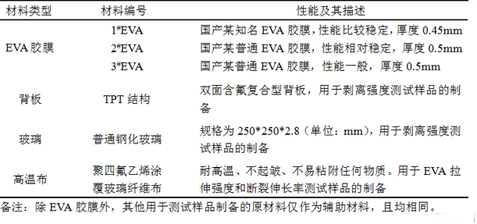
2.2 The main equipment
The main equipment and instruments used in the experiment are shown in Table 2.
Table 2 main equipment for testing and its use

2.3 Experimental design
In this paper, from the mechanical point of view, the different degree of cross-linking EVA, its own mechanical properties and the difference between the bond strength and glass / TPT. In this test, three kinds of EVAs produced by different manufacturers were selected, and the test samples were stacked using high temperature cloth/EVA/EVA/high temperature cloth and glass/EVA/EVA/backboard; according to the basic principle of cross-link curing, Changing the lamination parameters of the sample Laminate the cured lamination sample (because the lamination time has a certain influence on the adhesion of the EVA to the glass/TPT, in order to avoid interference with the test results by this factor, the lamination parameters Setting the lamination time constant, only adjusting the laminating temperature to change the cross-linking degree of the sample), preparing different cross-linked test samples; using xylene extraction to determine the cross-linking degree of the sample, and then Perform tensile tests and peel strength tests.
3 Test and Characterization
3.1 Determination of cross-linking degree
The degree of cross-linking refers to the degree of cross-linking reaction of EVA small molecules to form a three-dimensional network structure, generally by measuring the gel content of EVA to reflect the cross-linked curing of EVA.
This article uses solvent extraction method to determine the degree of cross-linking EVA, the test principle is to EVA sample boiling xylene solution extraction, uncrosslinked EVA all dissolved in xylene solution, and cross-linked EVA macromolecule can not Dissolved, the degree of cross-linking was determined by the ratio of the amount of residual sample to the total amount of the sample.
Test steps:
1. Extracted cross-linked EVA samples, loaded into a 120 mesh stainless steel mesh bag of known weight (marked as W1), and weighed on an electronic analytical balance (reported as W2);
2. The sample bag into xylene solution, boiled for 5 hours, extraction;
3. Place the sample bag in a vacuum oven. The oven is set at 140°C. After baking for 3 hours, remove it and weigh it (recorded as W3).
The formula for calculating the degree of crosslinking is as follows:
Degree of cross-linking (%)=[(W3-W1)/(W2-W1)]×100%
3.2 Determination of tensile strength and elongation at break
Tensile strength is the ultimate ability to characterize the resistance (tensile) failure of a material. The mechanical strength of an EVA sample can be characterized mechanically by measuring the tensile strength after EVA cross-linking; elongation at break is an important measure of the toughness (elasticity) of a material. The index, materials with greater elongation at break have a certain degree of elastic elongation when resisting impact and will not be brittle.
According to the national standard GB/T528-1998, the tensile strength and elongation at break of EVA film are tested with Universal Electronic Tensile Testing Machine. The tensile rate is 50mm/min. The test sample is made into a dumbbell type tester with a punching machine. Samples, width 10mm, length 50mm, using a micrometer to measure the thickness of the sample.
Tensile strength is calculated as follows:
Ts=Fm/(W ̇T)
In the formula: Ts-tensile strength (Mp)
Fm - maximum breaking force (N)
W-EVA Strip Actual Width (mm)
Thickness of T-EVA strip (mm)
Elongation at break is calculated as follows:
Elongation at break = (ΔL/L) × 100%
In the formula: ΔL- tensile extension length of the specimen at break (mm)
L-sample original length (mm)
3.3 Determination of Peel Strength
Peel strength, also known as bond strength, is an important indicator of the bonding and sealing effect between materials. The sample for measuring adhesion strength between EVA and glass, EVA, and TPT was a "glass/EVA/EVA/TPT" laminate, and the sample was completed on a solar module laminator apparatus.
This article according to GB/T2791-1995 "adhesive 180 ° peel strength test method", with a universal electronic tensile testing machine to test the adhesive strength between EVA and glass, EVA and backplane, peel rate is 100mm/min, sample The width is 10mm.
Peel strength calculation formula is as follows:
Δ180°=F/B
Where: δ180°-180° peel strength, N/cm;
F-average peel force, N;
B-sample width, cm.
4 Results and Discussion
4.1 Effect of Degree of Cross-linking on EVA Tensile Strength and Elongation at Break
Table 3 shows the test results of the tensile strength and elongation at break of some EVA samples.
Table 3 Tensile Strength and Elongation at Break for Different Degrees of Cross-linking EVA Samples
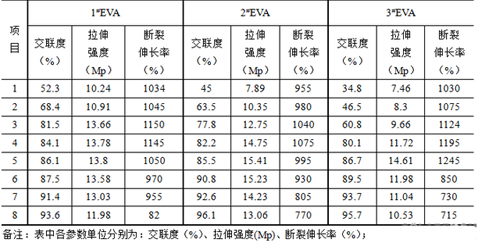
According to the tensile test results in the above table, the variation curves of the tensile strength and elongation at break of EVA with the cross-linking degree are plotted, as shown in Fig. 1 and Fig. 2, respectively.
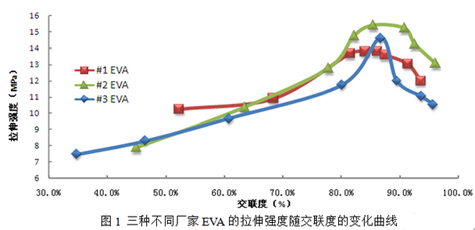
Figure 1 shows that cross-linking modification of EVA can significantly increase the tensile strength of EVA. Uncross-linked EVA is a linear polymer with a certain degree of polymerization strength. The material exhibits "soft and weak" characteristics; with the progress of the cross-linking reaction, new chemical bonds are formed between EVA macromolecules, making the EVA transition from a linear structure to a three-dimensional network structure. Improve the cohesive strength of EVA to make it have better resistance to mechanical damage. At this time, the material exhibits "tough and strong" characteristics; but with different types and cross-linking degrees of EVA, its tensile strength has a certain degree of The difference, and the relationship between the tensile strength of EVA and the degree of cross-linking is a "peak" curve. When the degree of crosslinking exceeds 90%, EVA is rapidly changed from a plastic material to a solid material, and the slope (absolute value) of the curve is large. As the material becomes harder and easier to break, the polymer exhibits more and more "hard and brittle" characteristics. It can be clearly seen from the figure that the cross-linking degree of EVA is between 80% and 90%, and especially at about 87%, the tensile strength of EVA is the best.
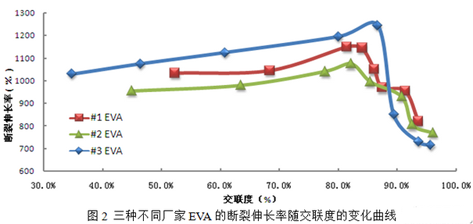
FIG. 2 depicts the variation of the elongation at break of EVA with the degree of cross-linking. The characteristic of this curve is: In the early stage, with the increase of the cross-linking degree of EVA, the elongation at break gradually increases; after reaching the peak, especially after the cross-linking degree exceeds about 86%, the elongation at break is fast. decline. When the degree of crosslinking of EVA is greater than 90%, its elongation at break has become very low. This shows that as the degree of cross-linking increases, its elastic stretchability also becomes worse and worse.
We can see that the curve of tensile strength and elongation at break of EVA with the degree of cross-linking is a "peak" curve; although there are some differences in the composition and quality of the EVA of the three manufacturers, when When the degree of crosslinking of EVA is about 85%, both the tensile strength and the elongation at break are located near the peak point.
4.2 Effect of Degree of Cross-linking on Adhesion Performance of EVA
EVA film is used as an adhesive in actual use, and the various materials of the crystalline silicon photovoltaic module are bonded together to function as a sealer. Different degrees of cross-linking EVA, the bond strength is different, Table 4 lists the EVA sample bond strength with the degree of cross-linked test results.
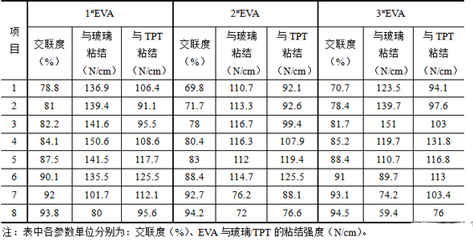
According to the test data in Table 4, plots of the peel strength of EVA samples and glass/TPT backplanes of the three manufacturers 1#, 2#, and 3# with the degree of cross-linking were plotted (as shown in the figure below).
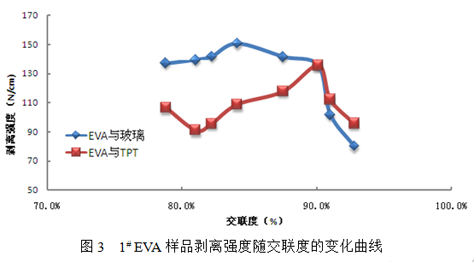
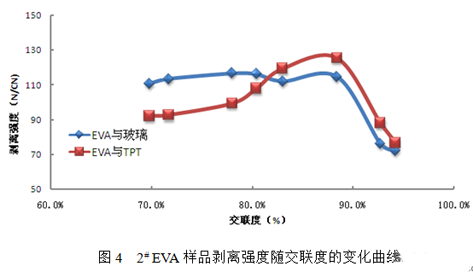
Figure 3, Figure 4, Figure 5 can be seen: With the increase in the degree of cross-linking, for different manufacturers, different types of EVA (different distribution ratio), the peeling strength of the glass and backplane have a change curve First increase and then decrease the law, but the peak corresponding to the degree of EVA cross-linking there is a certain difference, relatively more discrete. In general, the maximum peel strength of the three EVA and glass/TPT is within 80% to 90% of the EVA crosslinking degree. When the degree of cross-linking of EVA is greater than 90%, the peel strength value decreases rapidly, especially the peel strength of EVA and glass.
From the data of this study, in the component packaging technology of the photovoltaic industry, the degree of cross-linking of EVA is set at 85%, and is controlled within the range of 80% to 90%, which can well guarantee the mechanical properties of EVA. In the best range.
Due to the large number of models of EVA manufacturers on the market and the quality of the products varies, this test uses a product of a well-known manufacturer with a large amount of usage in the industry as a research sample, which has a certain representativeness. Although there are some uncontrollable factors in the sample preparation and experimental operations (for example, the quality difference of the samples from different manufacturers, the thickness uniformity of EVA samples after lamination has some differences, etc.), this study establishes a large number of sample tests and data. On the basis of statistical analysis, it has good reliability and stability, and has certain reference value for the packaging process of components.
5 Conclusion
(1) Chemical cross-linking is used to transform the linear molecules of EVA into a three-dimensional network structure, which enhances the cohesive strength of EVA, mainly manifested by its tensile strength, elongation at break, and peel strength of glass/backsheet. Has been greatly improved;
(2) With the increase of the degree of cross-linking of EVA, its mechanical properties all have the law of first increase and then decrease, and the greater the degree of cross-linking, the better the mechanical properties of EVA. And, the maximum points of its mechanical properties are basically distributed between 80% and 90%. We also found that when the degree of cross-linking reaches a certain degree (more than 90%), EVA will gradually exhibit "hard and brittle" characteristics, especially its elongation at break and the peel strength with glass will drastically decline;
(3) In the component packaging technology of the photovoltaic industry, it is recommended that the degree of cross-linking of EVA be set at 85% and controlled within the range of 80% to 90%.
Stainless Steel Cutting Board Rack
Cutting Board Rack,Cutting Board steel rack,Cutting Board Organizer rack,Stainless Steel Cutting Board Rack,Chopping Board Rack,Stainless Steel Chopping Board Rack, The materials are used 304 stainless steel, easy to clean, never rust!
Kichen Rack is made of high quality 304 stainless steel, This kind of material steel luxury, never rust, resist corruption, easily clean, safe, healthy and durable. Prevent rust or chemicals from contaminating food and damaging health
Cutting Board Storage Rack,Cutting Board Holder,Stainless Steel Cutting Board Rack,Chopping Board Rack
Shenzhen Lanejoy Technology Co.,LTD , https://www.bbq-grillgrate.com